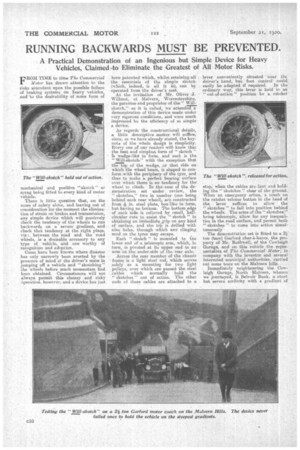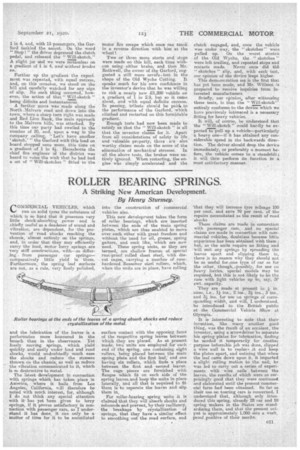RUNNING BACKWARDS MUST BE PREVENTED. • A Practical Demonstration of an
Page 10

Page 11

If you've noticed an error in this article please click here to report it so we can fix it.
Ingenious but Simple Device for Heavy Vehicles, Claimed,to Eliminate the Greatest of All Motor Risks.
LAROM TIME to time The Commercial Motor has ,drawn attention to the risks attendant upon the possible failure of braking systems on heavy 3;ellicles, and tothe desirability of some form of
mechanical and positive "skotch" or sprag being fitted to every kind of motor vehicle.
There is little _question that, on the score of safety alone, and leaving out of consideration for the moment the elimination of strain on brakes and transmission, any simple device which will positively check the tendency of the wheels to run backwards on a severe gradient, and check that tendency at the right plac,e, viz between the road and the road wheels, is a desirable accessory to any type of vehicle, and one worthy of recognition and adoption.
Cases have been known where disaster has only narrowly been averted by the presence of mind of the driver's mate in jumping off a vehicle and "skotching " the wheels before much momentum had been obtained. Circumstances will not. always permit this clumsy and risky operation, however, and a device has just been patented which, whilst retaining all the essentials of the simple sketch. (which, indeed, is all it is), can be operated from the driver'sseat.
At the invitation of Mr. Oliver J. Willmot, of Malvern, Worcestershire, the patentee and proprietor of the' skotcht,"• as it is called, we attend= demonstration of this device made under very rigorous conditions, and were much impressed by the efficiency of so simple
a device.
As regards the constructional details, a little descriptive matter will suffice, since, as we have already stated, the keynote of the whole design is simplicity. Every one our reaelerS will know that the hest and simplest form of " skotch " Is wedge-like in form, and such is the. "Will-skotch..' with the exception that the top of the wedge, or that side on which the wheel bears, is shaped to conform with the periphery of the tyre, and thus to make a, perfect bearing surface over which there is no tendency for the wheel to ohmic In the case of the demonstration set under review, the "skotches," two in number (one being behind each rear 'wheel), are constructed from in. steel plate, box:Iike in form, but. having no bottom. The bottorrcedge of each side is relieved by small, halfcircular cuts to assist the ' skotch " in obtaining an iminediate,i,nip on any kind of surface, and the top is drilled with nine holes, through which any clinging mud on the tyres may escape.
Each " skotch " is mounted to the lower end of a telescopic arm, which, in turn, is pivoted at its upper end to an arm on the under-side of the rear axle. Across the rear member a the chassis frame is a light steel rod, which serves solely as a mounting for two light pulleys, over which are passed the steel cables which normally hold the " skotches " out of action. The other ends of these cables are attached to a
lever conveniently situated near tin driver's band, but, foot control could easily be adapted if required. In the ordinary way, this lever is held in an "out-of-action " position by a ratchet
stop, when the cables are taut and holding the " skotches clear of the ground. When an emergency arises, a touch on the ratchet -release button in the head of the lever suffices to allow the " skotches " to fall into position behind the wheel's. The arms of the "skotches," being telescopic, allow for any inequalities in the road surface, and permit both " skotches " to come into action simultaneously The demonstiation set is fitted to a 21 ton (tare) Garford char4-bancs, the propetty of Mr. RotImell, of the Cowleigh Garage, and on this vehicle the representative of The Commercial Motor, in company with the inventor and several interested municipal authorities, carried out some tests .on the Malvern hills.
Immediately neighbouring the Cowleigh Garage, North Malvern, ielence we journeyed, is Belvoir Bank, a short. but severe acclivity with a gradient of
1 in 4, and, with 15 passengers, the Garford tackled the aScent. On the word " Stop I " the driver depressed the clutch pedal, and released the " Will-skotch." A slight jar and we were =unless on a gradient of 1 in 4, and without brakes On.
Further up the gradient the experiment was repeated, with equal success, and, on this occasion, we stood on the hill and carefully watched for any sign of slip. No such thing occurred, however, the action of thes" Will-skotch " being definite and instantaneous.
A further move was made along the North .Malvern road and down into the town, where a sharp turn right was made and Red Lion Bank, the main approach to the Malvern hills, was attacked. By this time our pasty had swelled to the number of 20, and, upon a wag in the company callings "Let's have another, 'sketch,'" the Garford with' this load on board stopped once more, this time ori a gradient of 1 in 4. Hereabouts the chief fire engineer of the district was heard to voice the wish that he had had a set of " Will-skotahes " fitted to the motor .fire escape which once ran gniok in a reverse direction with him at the -wheel I Two or three more starts and stopS were made on this hill, each time with. out using either brake, and then Mr. Bothwell, the owner of the Garford, 'suggested a still more severfe• test in the shape of the Old Wyche Cutting. It speaks much for his own confidence in the-inventor's device that he was willing to risk a nearly new .1,200 vehicle on a gradient of 1 in 2.9, but so it came about, and with equal definite success: In passing, tribute should be paid to the performance of the Garford, `which climbed and restarted on this formidable
gradient.
-Enough tests had now been Made to satisfy us that the " Will-sketch " is all that the inventor claims for it. Apart from all considerations of safety to life and valuable property, these are also worthy claims made on the snore of the
elimination of mechanical stresses. In all the above tests, the brakes were entirely ignored. When restarting, the engine was simply accelerated and the
dutch engaged, and, once the vehicle was under way, the "akotehes " were pulled up. On the worst stretch . of the Old Wyche, the " sketches " were left trailing, and repeated stops and restarts made. Never once did th-li " skotches " slip, and, with each test, our opinion of the device leapt higher.
This demonstration set is the first that has yet been made, and Mr. Willmot is prepared to receive inquiries from interested manufacturers.
Briefly, our opinian, after witnessing these tests, is that the " Will-skoteh" entirely conforms to the clev7rwhicli we have previously intimated is a necessary fitting for heavy vehicles.
It will, of course, be understood that the " Will-sketch " could hardly be expected to pull up a vehicle—particularly a heavy one—if it has attained any considerable speed in the backwards direction. The driver should drop the device immediately, or preferably a moment before, the vehicle comes to a standstill; it will then perform its function in a most satisfactors' mariner.








































